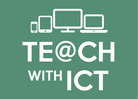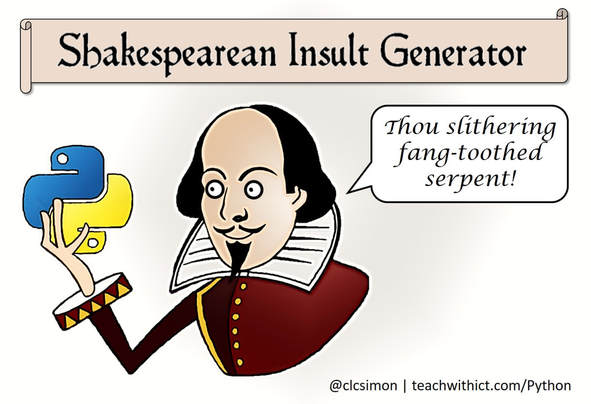Creating a Shakespearen Insult Generator – Part 1 (Python Tutorial)
Insult generator tutorial
Learning Objectives:
- Understand and use sequence in an algorithm
- Understand and use iteration in an algorithm (FOR and WHILE loops)
- Understand and use selection in an algorithm (IF, Else and Else if)
- Understand and use data structures in an algorithm (for example, Lists, Tables or Arrays)
Curriculum Mapping:
KS2:
- Design, write and debug programs that accomplish specific goals; solve problems by breaking them into smaller parts. Select, use and combine a variety of software on a range of digital devices to design and create a range of programs.
- Use sequence, selection and repetition in programs; work with variables and various forms of input and output
- Use logical reasoning to explain how some simple algorithms work; detect and correct errors in algorithms and programs
KS3:
- Use two or more programming languages, at least one of which is textual, to solve a variety of computational problems.
STUDENT: COMPUTATIONAL THINKER:
- 5a: Students break problems into component parts, extract key information, and develop descriptive models to understand complex systems or facilitate problem-solving.
- 5c: Students break problems into component parts, extract key information, and develop descriptive models to understand complex systems or facilitate problem-solving.
- 5d: Students understand how automation works and use algorithmic thinking to develop a sequence of steps to create and test automated solutions.
EDUCATOR: COMPUTATIONAL THINKING COMPETENCIES:
- 4b: Design authentic learning activities that ask students to leverage a design process to solve problems with awareness of technical and human constraints and defend their design choices.
COMPUTER SCIENCE EDUCATORS:
- 2a: Plan and teach computer science lessons/units using effective and engaging practices and methodologies:
i. Select a variety of real-world computing problems and project-based methodologies that support active and authentic learning and provide opportunities for creative and innovative thinking and problem solving
ii. Demonstrate the use of a variety of collaborative groupings in lesson plans/units and assessments
iii. Design activities that require students to effectively describe computing artifacts and communicate results using multiple forms of media
iv. Develop lessons and methods that engage and empower learners from diverse cultural and linguistic backgrounds
v. Identify problematic concepts and constructs in computer science and appropriate strategies to address them
vi. Design and implement developmentally appropriate learning opportunities supporting the diverse needs of all learners
vii. Create and implement multiple forms of assessment and use resulting data to capture student learning, provide remediation and shape classroom instruction
CSTA K–12 CS Standards:
- 1B-AP-08: Compare and refine multiple algorithms for the same task and determine which is the most appropriate.
- 1B-AP-09: Create programs that use variables to store and modify data.
- 1B-AP-10: Create programs that include sequences, events, loops, and conditionals.
- 1B-AP-11: Decompose (break down) problems into smaller, manageable subproblems to facilitate the program development process.
- 1B-AP-13: Use an iterative process to plan the development of a program by including others' perspectives and considering user preferences.
- 1B-AP-15: Test and debug (identify and fix errors) a program or algorithm to ensure it runs as intended.
- 1B-AP-17: Describe choices made during program development using code comments, presentations, and demonstrations.
- 2-AP-11: Create clearly named variables that represent different data types and perform operations on their values
- 2-AP-12: Design and iteratively develop programs that combine control structures, including nested loops and compound conditionals.
- 2-AP-15: Seek and incorporate feedback from team members and users to refine a solution that meets user needs.
- 2-AP-16: Incorporate existing code, media, and libraries into original programs, and give attribution.
- 2-AP-17: Systematically test and refine programs using a range of test cases.
- 3A-AP-14: Use lists to simplify solutions, generalizing computational problems instead of repeatedly using simple variables.
- 3A-AP-15: Justify the selection of specific control structures when tradeoffs involve implementation, readability, and program performance, and explain the benefits and drawbacks of choices made.
AREA OF LEARNING AND EXPERIENCE: Science and Technology:
Computation is the foundation for our digital world.
Progression step 3
- I can use conditional statements to add control and decision-making to algorithms.
- I can identify repeating patterns and use loops to make my algorithms more concise.
- I can explain and debug algorithms.
Progression step 4
- I can decompose given problems and select appropriate constructs to express solutions in a variety of environments.
- I can select and use data structures that efficiently manage data in algorithms.
- I can plan and implement test strategies to identify errors in programs.
Progression step 5
- I can identify, define and decompose problems, choose appropriate constructs and express solutions in a variety of environments.
- I can use file-handling techniques to manipulate data in algorithms.
- I can test, evaluate and improve a solution in software.
How to make an Insult
To make an insult, pick one word from each of the columns (below), combine them to make a sentence and add the word “Thou” at the beginning. For example: If we were to take the first word from each of the 3 columns we would get:
Column 1 |
Column 2 |
Column 3 |
artless |
base-court |
apple-john |
In this lesson, students are going to create a Shakespearean Insult generator using lists in Python.
Starter:
Show students the online Shakespearean Insult generator (http://www.pangloss.com/seidel/Shaker/) or display a couple of random insults on the board as students enter the room e.g.
“Thou puny fly-bitten lout”
Before students create their Shakespearean insult generator, they need to become familiar with the random function in Python.
Tell students that they are going to write an algorithm to simulate the flipping of a coin.
Instruct students to type in and run the following code:
cointoss = random.randint(1,2)
if cointoss == 1:
print("Heads")
else:
print("Tails")
Extension:
Ask students to modify the code to simulate the rolling of a dice i.e. if the random function returns a 6, print the word “Six”.
Next, explain to students that they are going to create a random name picker and this will form the basis of their Shakespearean Insult generator.
1. Instruct students to type in and run the following code:
|
import random
names = ["Bob", "Dave", "Stuart"] print(names[random.randint(0,2)]) |
Explain to students that lists start at 0 NOT 1.
e.g. if we were to run the following code:
print(names[0])
The computer would return the name “Bob”
2. Ask the students to replace the last line with the following new code:
|
print(random.choice(names))
|
Ask students to run the new script and explain what the new code does.
3. Finally, inform students that we need to add (concatenate) the word “Minion” at the beginning of our randomly selected name.
Ask students to replace the last line with the following:
|
print(“Minion” + “ “ + random.choice(names))
|
Extension:
Ask students to add more names to the list.
Explain to students how the online Shakespearean Insult generator works (see introduction) and direct them to the Shakespearean Insult toolkit (http://www.pangloss.com/seidel/shake_rule.html)
Instruct students to, using what they have learnt and using the resources at their disposal, create their very own Shakespearean Insult generator. Tell students that they will need to use lists and that they will also need to use the random function.
Tip: If you prefer, you may wish to provide students with a template with the lists already created (see below) – this will save the students from having to type all the words. You can then ask the students to add a fourth list with alternate sentence starters e.g. “Thou”, “Thee”, “Ye Olde” etc.
| shakespearean_insult_template.py |
| insult_creator_v1.py |
Extension: Tkinter
Tkinter is the default GUI that is shipped with Python. With tkinter, it is easy to create GUIs to use with your Python code such as windows and buttons.
| insult_creator_v2_tkinter.py |
2. Ask students to comment their code, using the hashtag (#), explaining what the code is doing
Alternative:
Alternatively, you could ask students to create a random compliments generator.
Next: Part 2 – File handling
Unless otherwise specified, everything in this repository is covered by the following licence:
Based on the Shakespearean Insulter: http://www.pangloss.com/seidel/Shaker/




